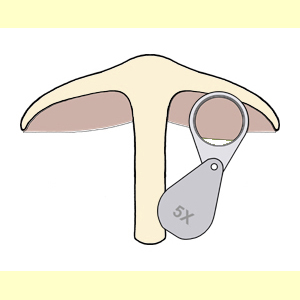
Observe the colour of the lamellae edge by turning over the fruit-body and looking at the lamellae side-on at an angle. Use a x5 hand lens to look carefully at the lamellae edges.
Lamellae edge colour is best observed in young fruit-bodies, because the edge may erode with age and the colour contrast may then be less obvious, especially where the edges are pale or white against a darker lamellae face. Paler or darker edges usually indicate the presence of microscopic cheilocystidia (sterile elements on the lamellae edge).
Choose this state if: the edge of the lamellae is more or less the same colour as the face, and there is no paler or darker line along the lamellae edge.
In older specimens spores may deposit on the lamellae edge, giving it a different colour. On drying, the lamellae can change colour (often becoming darker). Neither spore deposits nor drying will produce a paler or darker line along the lamellae edge.
